Amarok/QuickStartGuide/TheMusicCollection/pt-br: Difference between revisions
Created page with "Você pode estar se perguntando porque o painel de '''Fontes de mídia''' não é chamado de painel de 'Coleções'. O '''Amarok''' lhe fornece acesso a muito mais músicas do..." |
Created page with "{| class="tablecenter" border=1 ! Painel de fontes de mídias ! Ícone Arquivos clicado |- | 250px|thumb || [[Image:Amarokmediasour..." |
||
| Line 50: | Line 50: | ||
{| class="tablecenter" border=1 | {| class="tablecenter" border=1 | ||
! | ! Painel de fontes de mídias | ||
! | ! Ícone Arquivos clicado | ||
|- | |- | ||
| [[Image:Amarokmediasources-home.png|250px|thumb]] || [[Image:Amarokmediasources-files.png|250px|thumb]] | | [[Image:Amarokmediasources-home.png|250px|thumb]] || [[Image:Amarokmediasources-files.png|250px|thumb]] | ||
Revision as of 00:31, 10 September 2012
Coleção de músicas
Painel de fontes de mídia
O painel de Fontes de mídias é o local onde você navega e exibe sua coleção de músicas completa. Isto inclui as faixas em seu disco local, bem como as que estejam em qualquer dispositivos ou mídias conectadas ao seu computador, como CDs de áudio, dispositivos USB, reprodutores de mídia, discos de rede ou fontes da Internet.
Configurando uma coleção
Você possui faixas de música no formato mp3, Ogg ou FLAC em seu computador? Comece dizendo ao Amarok onde encontrar estes arquivos, assim ele pode criar sua coleção. Na barra de menu: .
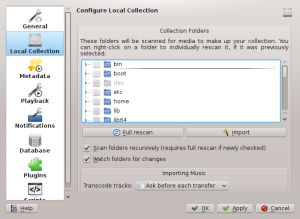
Uma visão em árvore de sua pasta pessoal é exibida acima. Clique na caixa onde sua música está armazenada, normalmente em . Então selecione . Isto levará algum tempo, então não fique preocupado se o Amarok parecer estar lento por um tempo. Uma vez que o escaneamento tenha terminado, é melhor sair do Amarok usando o menu do ou Ctrl + Q, e então reiniciá-lo. Suas músicas recém adicionadas deverão ser exibidas na seção da Coleção local.
Mais sobre como configurar sua coleção aqui.
Adicionando dispositivos de mídia à sua coleção
Abaixo da barra de pesquisa, próximo ao topo do painel de Fontes de mídias você verá diferentes dispositivos e/ou categorias de conteúdo dentro do Navegador de conteúdo. Se você inserir um CD de áudio no leitor de CDs, ele aparecerá no painel de Fontes de mídias, juntamente com reprodutores de mídia, pendrives e outros dispositivos USB. Após um dispositivo externo ter sido montado, ele será exibido automaticamente no painel de Fontes de mídias.
Abaixo está uma imagem mostrando três fontes de músicas conectadas: CD de áudio, reprodutor mp3 e a Coleção local.
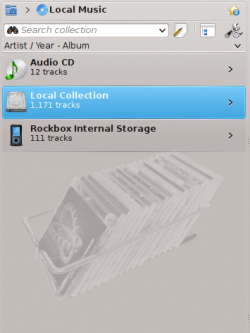
Extraindo músicas de um CD para sua coleção
Se você ainda não possui nenhum arquivo de música em seu computador, é fácil extraí-las (copiar as faixas de seus CDs para a sua coleção). Basta carregar um CD e clicar com o botão direito do mouse na faixa do dispositivo de CD no Navegador de conteúdo, para reproduzir ou copiar para sua coleção, o que irá extrair e marcar as suas faixas (veja a imagem abaixo). Se você copiar músicas de um CD de áudio para sua Coleção local, a barra de mensagens na parte inferior da janela do Amarok indicará que ele está ocupado fazendo a cópia. A extração pode levar vários minutos. Quando estiver concluída, a mensagem na barra de mensagens desaparecerá e a música aparecerá no navegador de conteúdo da sua Coleção local. Se a música extraída não aparecer no seu painel de Fontes de mídias saia do Amarok usando o menu ou use o Ctrl + Q, e então reinicie-o. Agora você deve vê-la na sua coleção. A imagem abaixo mostra como você move faixas de um CD de áudio, iPod ou outro dispositivo para a sua coleção usando o menu do botão direito do mouse.
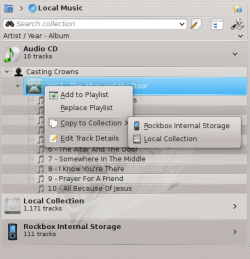
No menu de contexto acima, você pode também ver a opção para . Use esta opção se você possuir uma faixa que precisa ter suas marcas editadas. Isto se torna importante quando você ripa músicas para o formato .WAV, perdendo algumas das marcas. Se uma boa parte de sua coleção precisar ser marcada, considere a possibilidade de usar um programa específico para marcação, tais como
A marcação correta é importante para auxiliar o Amarok a mostrar suas faixas nos álbuns apropriados e na ordem correta. Aprenda mais sobre extração e marcação.
Acessando outras fontes de mídia
Você pode estar se perguntando porque o painel de Fontes de mídia não é chamado de painel de 'Coleções'. O Amarok lhe fornece acesso a muito mais músicas do que as existentes em sua coleção -- lojas na Internet, livros de áudio, podcasts, arquivos de músicas armazenados fora da sua coleção, e listas de músicas previamente salvas. A área de navegação do Amarok é a chave para tudo isto. O ícone de inicial para a área de navegação é o da pasta com uma casa no canto superior esquerdo do painel de Fontes de mídias. Este ícone se expande e contrai conforme você navega pelo painel de Fontes de mídias, permitindo-lhe navegar facilmente pela sua coleção clicando na pasta desejada na sua barra de navegação.

If you click the Amarok home folder you see the Media Sources pane on the left below, containing icons to available resources. If you click (left image below, second item from the bottom), you will see something similar to the image on the right, below. Notice how the breadcrumb bar expands and how the content of the selected folder is shown in the Media Sources pane (right image below). Clicking the > symbols among the breadcrumbs allows you to view the folders available at that level of the folder structure. The Amarok file browser gives you access to your entire file system, even outside your Local Collection.
| Painel de fontes de mídias | Ícone Arquivos clicado |
|---|---|
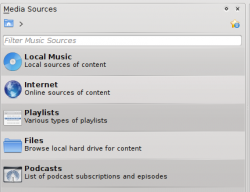 |
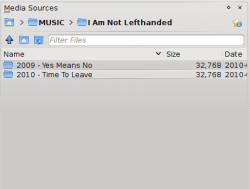 |
The functions of the icons in the Amarok Home folder (left above) are:
| Icon | Name | Action |
|---|---|---|
| Your Amarok collection | ||
| Internet shops such as Magnatune, Jamendo and Last.fm. First configure your internet resources in: | ||
| Saved playlists -- see also Playlists. Also playlists on media devices | ||
| Your file system | ||
| Access to Podcasts via RSS feed |
Clicking in the root of Media Sources (image above) or in the breadcrumb bar returns you to your collection, showing you a list of all the available resources, artists, albums and tracks that you have previously defined as part of your collection. The breadcrumb bar indicates that you are viewing Local Music.
Streams and Podcasts
There are two ways to listen to streams.
- If you have a favorite station, get the stream URL and add it: . If you then save your playlist, later you can find it again in Playlists, as a Saved Playlist.
- Browse through the scripts available in our Script Manager, up to Amarok 2.4.0, after 2.4.1 . There are some excellent collections available, which will show up in the Internet section of your Media pane.
Podcasts have their own section in the Media pane, above. If you have an RSS or Atom feed URL, click the ![]() and add it there. If you have an OPML file to import, that choice is available also. Use the context (right-click) menus to , , , , or mark an episode as . If you are interested in browsing through a large collection of podcasts, check out the Podcast Directory available through the Script Manager, referred to above.
and add it there. If you have an OPML file to import, that choice is available also. Use the context (right-click) menus to , , , , or mark an episode as . If you are interested in browsing through a large collection of podcasts, check out the Podcast Directory available through the Script Manager, referred to above.
More about configuring Amaroks Internet Services here.
Using the Content Browser
The hard disk of your computer, audio CDs, external devices and the Internet are the basic resources for your collection. After your collection has been set up, it is likely that your collection will hold a large number of albums and tracks, much more than can be shown on a single window.
How to change the display of your collection, below:
Hiding or expanding information
The area of the Media Sources pane below the search bar is called the Content Browser. Three media sources are indicated in the image of a Content Browser below: CD, Local Collection and a Media Player:

Clicking the banner for a device (the blue bar for the Sansa above) shows or hides the content of that device. The direction of the arrow on the right indicates whether the contents for that device is hidden or shown. The content on a particular device can, in turn, be hidden or shown using the same principle, clicking on the appropriate artist or album. An arrow pointing down on the left of an artist or an album indicates that the contents has been expanded. An arrow pointing right indicates that more content for that category is available but currently hidden. In the image above, the information for Mike Oldfield - The Songs of Distant Earth CD has been expanded, showing the individual tracks. On the other hand, the albums and tracks in the Local Collection are hidden. By clicking these arrows you also can expand or hide information.
Changing the order of tracks and albums
The order in which tracks are sorted in the Content Browser can be customised by using the ![]() button at the top of the Media Sources pane:
button at the top of the Media Sources pane:
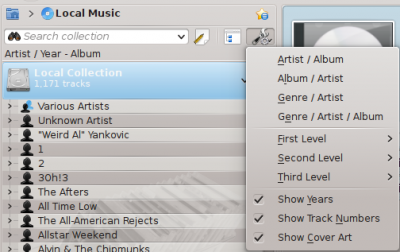
The sort order is indicated on the top left of the Media Sources pane, just below the Search text box. The default order is Artist / Year - Album. The display order of the Content Browser can be temporarily switched between the user-defined sort order (described above) and a Merged view in which which artists are listed alphabetically, no matter on which media the music is stored. To toggle the Merged view, click the ![]() icon at the top right-hand of the Media Sources pane:
icon at the top right-hand of the Media Sources pane:
To search your collection, type your search term into the Search bar at the top of the Local Music section. Not only can you search by artist, album or track name, but any part. You might create a nice playlist by searching for winter, for instance, or merely find a track when you only remember one word of the title. You can also search by rating, playcount, even filetype. See Search in Collection for more details.
Deleting items from the collection
You can delete any item from your collection by right-clicking on it and choosing the bottom item . A confirmation dialog will appear, preventing the accidental deletion of any tracks. More than one item can be selected with Ctrl + click.


